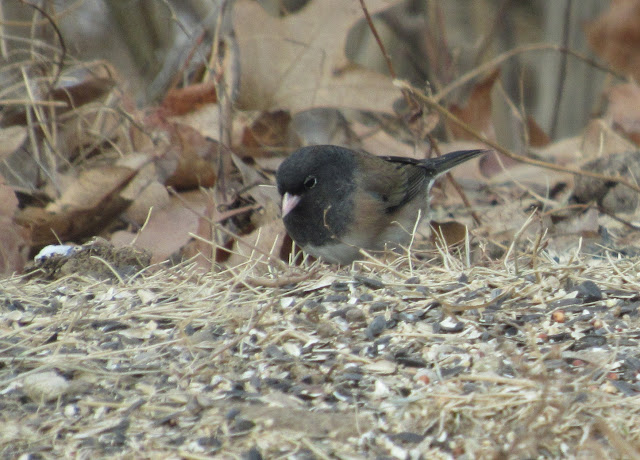We are firmly in Eagle season this year. This year has been either cold or warm with fog and ice storms, so far. An ice storm back in December inspired this photo of frozen fields:
I haven't been out a whole lot, but I did make it out recently to Lake Springfield.
There wasn't much but melting ice at Marine Point, though I had a few flyover Greater White-fronted Geese (Anser albifrons), which I didn't expect.
More unexpected geese roamed about Center Park, the Cackling Geese (Branta hutchinsii) above. They're smaller, including their bills, than a regular Canada Goose (Branta canadensis).
Just down the road, I found an Oregon Junco (Junco hyemalis [oreganus Group]) eating some seeds. It was my first of the two rarer birds of the day. This is definitely an Oregon Junco, due to the chestnut coloring on its back and sides. Oregon Juncos are the far less common subspecies of the regular backyard Dark-eyed Junco.
Literally across the road from the Oregon Junco was the Mystery Goose, whom really needs a name. I propose Whitey, considering how pale it is.
I then ventured on down towards the dam, where the power plant's warm water discharge keeps an open area in the ice all winter long. This leads to a concentration of wildlife, particularly of the avian variety. The best place to view this gathering of winter birds is across the lake at the parking lot of Lincoln Greens Golf Course, which is open to the public. The first bird I noticed was a Bald Eagle (Haliaeetus leucocephalus), directly in front of me on the ice.
Just behind it was the largest flock of Common Mergansers (Mergus merganser) I have ever seen, of which only a portion is below:
Here's the majority, with the power plant looming behind:
The ice and the Bald Eagle made for a great photography subject.
Far off in the back, I spotted a couple of Black Ducks (Anas rubripes), which I don't see too often:
Even further back were sixteen Great Blue Herons (Ardea herodias) and one American White Pelican (Pelecanus erythrorhynchos), here due to the warmth of the power plant's hot water discharge. The lake's waters are used to cool the power plant's generators, and the resulting hot water is pumped back out into the lake, creating a birding hotspot during winter.
This open-water area across the bay had hundreds more ducks and gulls, as well as six of the nine eagles I saw over the course of my visit.
Four of those eagles decided to sit in one tree!
While I was unable to get a good photo of it, I also spotted a Greater Black-backed Gull out on the ice, as well as a few white-winged gulls of unknown species. The lifer Greater Black-backed Gull may have been the best bird, but this eagle below, which remained on the ice right in front of me for a very long period of time. It was a good day, and I hope to get out soon again sometime.
Ebird Checklists:
http://ebird.org/ebird/view/checklist/S33573535
http://ebird.org/ebird/view/checklist/S33573340


















No comments:
Post a Comment